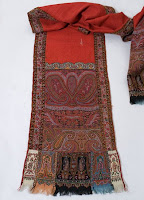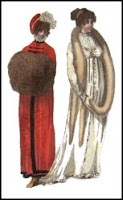 OK, I admit it. I’m still in my odd nightwear and wearing a wonderful shawl which I affectionately call the horse blanket because it is so very large. The heat isn’t on yet because my office is sunny but my feet are cold…
OK, I admit it. I’m still in my odd nightwear and wearing a wonderful shawl which I affectionately call the horse blanket because it is so very large. The heat isn’t on yet because my office is sunny but my feet are cold…
We have another big storm in the forecast for the Washington DC area this weekend. Here I am digging out the last one, wearing the most unflattering pants in the world and my Attila the Hun hat. Pic courtesy of my husband who was safely inside. I quite enjoy digging out because I get to chat with the neighbors but I didn’t expect to do it again.
So how did Regency ladies, in their flimsy muslins, fare in the winter? Those elegant Georgian fireplaces look great but might not throw out a whole lot of heat; or more likely, they’d be hot enough to necessitate the use of a firescreen (to protect the complexion, not to prevent wax makeup melting–that’s a myth) while your back froze.
 I’m pretty sure women could resort to woollen petticoats, although I haven’t been able to find a whole lot of evidence of any existing. In the eighteenth century, and later in the nineteenth century as skirts became full again, quilted petticoats, like this gorgeous example from Williamsburg, were worn.
I’m pretty sure women could resort to woollen petticoats, although I haven’t been able to find a whole lot of evidence of any existing. In the eighteenth century, and later in the nineteenth century as skirts became full again, quilted petticoats, like this gorgeous example from Williamsburg, were worn.
 In the Regency, of course, shawls were in fashion, like this amazing red wool twill with embroidered panels. I found it at vintagetextile.com, a site well worth looking at (and for breeding covetousness).
In the Regency, of course, shawls were in fashion, like this amazing red wool twill with embroidered panels. I found it at vintagetextile.com, a site well worth looking at (and for breeding covetousness).
 At the same site I discovered this gown from 1800, made of silk faille, that looks warm even if it isn’t. Wouldn’t this be a great dress to make a heroine stand out in society…
At the same site I discovered this gown from 1800, made of silk faille, that looks warm even if it isn’t. Wouldn’t this be a great dress to make a heroine stand out in society…
 Outside (the thought of wind whistling up however many petticoats, whatever they were made of, makes me shiver) the well dressed woman would wear a muff and/or tippet. You’ll be glad to hear that muffs became smaller than this monstrosity. She isn’t carrying a hedgehog.
Outside (the thought of wind whistling up however many petticoats, whatever they were made of, makes me shiver) the well dressed woman would wear a muff and/or tippet. You’ll be glad to hear that muffs became smaller than this monstrosity. She isn’t carrying a hedgehog.
 And she’d probably wear pattens, still around since medieval times, to protect her feet from the mud and muck of the street, although walking on ice in these must have been hazardous.
And she’d probably wear pattens, still around since medieval times, to protect her feet from the mud and muck of the street, although walking on ice in these must have been hazardous.
How’s your winter weather and what do you like to wear when it’s cold, indoors or out?
SSP: Title and release date–October 2010, Jane & the Damned (HarperCollins); and Improper Relations is still on sale, with free shipping worldwide, at bookdepository.com.












